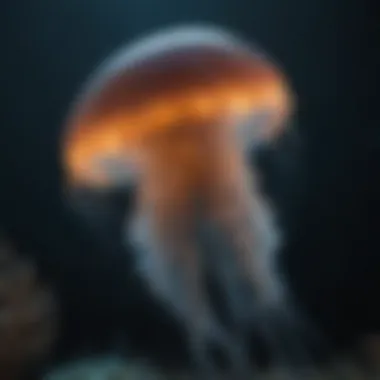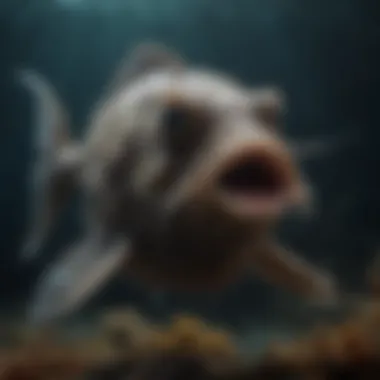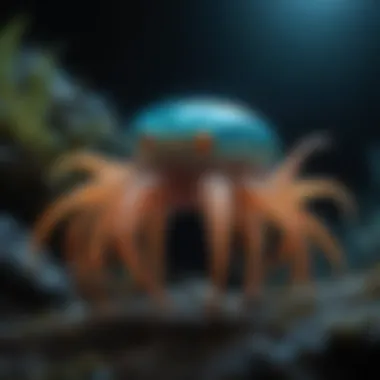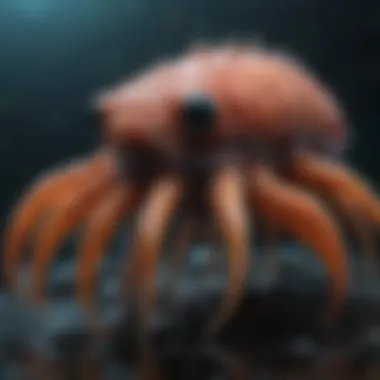Unveiling the Mysterious Life Forms of the Ocean Depths: Exploring Strange Deep Sea Creatures


Nature Topic Overview
When pondering the enigmatic depths of the oceans, one cannot help but be astounded by the strange and fascinating organisms that call these mysterious waters home. From the ethereal glow of bioluminescent jellyfish to the eerie allure of anglerfish lurking in the shadows, the deep sea is a realm of otherworldly beings waiting to be unveiled.
Fun Facts and Trivia
Diving into the realm of deep-sea oddities reveals a trove of intriguing tidbits that can captivate the curiosity of young minds. Did you know that the colossal squid has eyes the size of dinner plates, allowing it to see in the dark depths where sunlight can't reach? Explore these astonishing facts with interactive elements and visuals that bring these bizarre creatures to life.
Wildlife Explorations
Embark on a journey to discover the myriad species that inhabit the murky depths of the ocean. Learn about the unique adaptations of creatures like the gulper eel, which can swallow prey larger than itself thanks to its distensible stomach. Engage with quizzes and puzzles that test your knowledge of these extraordinary denizens of the deep.
Environmental Awareness
Amidst the awe-inspiring spectacle of deep-sea wonders lies a crucial message of conservation and sustainability. Delve into the importance of preserving marine ecosystems to protect the habitats of these remarkable creatures. Gain insights into how children can contribute to safeguarding nature and promoting a harmonious balance between human activities and the environment.
DIY Nature Activities
Bringing the wonders of the deep sea into your home, engage in hands-on activities that showcase the marvels of underwater life. Follow step-by-step guides to create nature-inspired crafts that emulate the beauty of bioluminescent jellyfish or embark on outdoor explorations that mirror the habitats of strange deep-sea dwellers. Encourage young explorers to delve deeper into the mysteries of the ocean with creative and immersive projects that spark a love for nature.
Introduction to Deep Sea Mysteries
Diving into the depths of the ocean unveils a world shrouded in enigma and fascination. Exploring the mysterious life forms residing in the abyssal zones opens doors to a realm rarely encountered by human eyes. The significance of delving into these deep sea mysteries lies in unraveling the secrets of organisms perfectly adapted to survive in extreme conditions. By shedding light on these bizarre creatures, we gain insight into the unparalleled diversity of underwater ecosystems, showcasing nature's ingenuity at its finest.
The Enigmatic World of the Deep Sea
Exploring the Uncharted Depths
Embarking on voyages to explore the uncharted depths of the ocean yields invaluable discoveries. The allure of venturing into unknown territories drives scientists and explorers to uncover hidden species and geological wonders. The abyssal plains, with their mysterious landscapes and unknown life forms, serve as a canvas for scientific exploration, unveiling the intricacies of deep sea ecosystems.
Extreme Conditions of the Abyss


The extreme conditions prevailing in the abyssal realms present a myriad of challenges and opportunities for life to thrive. From bone-crushing pressures to perpetual darkness, these harsh conditions foster unique adaptations in deep-sea organisms. Navigating through the frigid, dark waters requires specialized traits that set deep-sea dwellers apart from their shallow-water counterparts.
Adaptations for Survival
Survival in the abyss demands radical adaptations honed through millennia of evolution. From bioluminescence to bizarre anatomical features, deep-sea creatures showcase a repertoire of survival strategies. Enduring the scarcity of food and the absence of sunlight, these organisms have evolved to exploit every niche, highlighting the fierce competition inherent in the deep sea.
Importance of Deep Sea Exploration
Venturing into the depths of the ocean goes beyond mere curiosity; it fosters scientific breakthroughs and conservation efforts crucial for maintaining biodiversity.
Scientific Discoveries and Advancements
The exploration of deep sea ecosystems unveils a trove of scientific discoveries and technological advancements. From uncovering new species to studying extremophiles, every expedition contributes to expanding our knowledge of marine biology and evolution. The deep sea serves as a vast laboratory, offering insights into the resilience and adaptability of life forms in the face of adversity.
Conservation Efforts in Deep Sea Ecosystems
Preserving the delicate balance of deep sea ecosystems is imperative in the face of increasing human activities. Conservation efforts aimed at protecting vulnerable species and habitats play a pivotal role in safeguarding the biodiversity of the ocean depths. By raising awareness and implementing sustainable practices, we strive to ensure the longevity of these enigmatic ecosystems for future generations.
Weird Deep Sea Creatures Unveiled
Deep within the obscure depths of the ocean lies a realm teeming with enigmatic life forms that defy imagination. The significance of exploring these weird deep-sea creatures goes beyond mere curiosity; it unravels the intricate tapestry of underwater ecosystems, highlighting the marvels of evolution and survival strategies honed by these fascinating beings. From the luminous jellyfish to the ghostly anglerfish, each creature offers a unique perspective on adaptation and resilience in the harsh abyssal environment.
Luminous Jellyfish: Lights in the Darkness
Bioluminescence in Deep Sea Jellyfish
Diving into the mesmerizing realm of bioluminescence within deep-sea jellyfish, we encounter a phenomenon that illuminates the obscure underwater world. The radiance emitted by these creatures not only serves as a beacon in the darkness but also plays a pivotal role in attracting prey and signaling danger. The unique ability of bioluminescent deep-sea jellyfish to produce light offers insights into their survival tactics and ecosystem dynamics, casting them as intriguing subjects in the study of marine biology.
Role of Light in Deep Sea Ecology
The role of light in deep sea ecology transcends mere visibility; it shapes interactions among organisms, influences behavioral patterns, and contributes to the delicate balance of the ecosystem. Deep-sea creatures, including jellyfish, have evolved to harness light not just for illumination but as a tool for communication, camouflage, and predation. Understanding the significance of light in deep-sea environments unveils a nuanced perspective on the interconnectedness of marine life forms and the adaptations necessitated by perpetual darkness.


Survival Strategies of Luminescent Species
In the perpetual darkness of the deep sea, luminescent species have honed remarkable survival strategies centered around their ability to emit light. Beyond mere visual spectacle, bioluminescence serves as a means of defense, communication, and prey attraction for these mesmerizing creatures. By delving into the intricacies of their luminescent adaptations, researchers unravel the cryptic world of deep-sea survival tactics and the evolutionary marvels that enable these species to thrive in one of Earth's most extreme habitats.
Ghostly Anglerfish: Masters of Camouflage
Unique Adaptations for Hunting
Among the eerie inhabitants of the deep sea, the ghostly anglerfish stands out as a master of camouflage and deception. Its unique adaptations for hunting, including bioluminescent lures and cavernous jaws, showcase evolutionary traits honed through millennia of natural selection. By blending seamlessly into the abyssal surroundings and employing ingenious tactics to attract prey, the anglerfish epitomizes the art of stealthy predation in a realm where visibility is a luxury.
Mating Peculiarities of Anglerfish
The enigmatic mating rituals of anglerfish shed light on one of nature's most bizarre phenomena. In the dimly lit depths where finding a mate is a daunting task, anglerfish have evolved unique reproductive strategies to ensure species propagation. From parasitic mating to symbiotic unions, these peculiar behaviors offer a glimpse into the tenacious drive for survival that characterizes deep-sea organisms, highlighting the resilience and adaptability embedded in their genetic makeup.
Behavioral Insights into Deep Sea Predators
Exploring the behavioral intricacies of deep-sea predators unveils a world of calculated strategies and instinctual patterns that govern survival in the abyss. From ambush hunting techniques to cooperative behaviors, these insights provide a glimpse into the elusive lives of creatures lurking in the deep. By deciphering the behavioral cues and ecological roles of deep-sea predators, researchers gain a comprehensive understanding of the complex web of interactions that define deep-sea ecosystems.
Giant Spider Crab: Arachnids of the Deep
Size and Adaptations of Spider Crab
The colossal presence of the giant spider crab looms large in the underwater panorama, its formidable size and intricate adaptations setting it apart as an arachnid of the deep. From its spindly limbs to armored carapace, the spider crab embodies resilience and efficiency in a hostile environment. By delving into the nuances of its size dynamics and adaptive features, we unravel the mysteries of one of the ocean's most captivating crustaceans, offering insights into its predatory prowess and survival tactics honed over centuries.
Feeding Habits and Interactions in Deep Sea
Navigating the depths of the oceanic food web, we encounter the intricate feeding habits and interactions of the giant spider crab with its marine counterparts. From scavenging on decaying matter to engaging in territorial disputes, the spider crab's role in ecosystem dynamics is as crucial as it is fascinating. By examining its feeding strategies and social interactions, we glean valuable insights into the interconnectedness of deep-sea life forms and the delicate balance that sustains this biodiverse realm.
Vampire Squid: Enigmatic Deep Sea Denizen
Unique Features of Vampire Squid


Enter the realm of the vampire squid, a mysterious denizen of the deep sea shrouded in enigmatic features and unparalleled adaptations. With its characteristic cloak-like webbing and bioluminescent displays, this creature embodies a miniaturized marvel of evolution sculpted by the demands of its lightless habitat. By unraveling the distinct features of the vampire squid, from its phosphorescent abilities to its peculiar morphology, we gain a deeper appreciation for the intricate tapestry of biodiversity woven beneath the ocean's surface.
Habitat and Lifestyle of Deep Sea Squid
Journeying through the habitat and lifestyle of the vampire squid offers a glimpse into the survival strategies and behavioral quirks of this elusive creature. From its deep-sea haunts to its feeding habits, the vampire squid navigates the abyss with a grace honed through millennia of evolution. By exploring its habitat preferences and lifestyle choices, researchers uncover the secrets of a resilient deep-sea inhabitant and shed light on the challenges of existence in a light-starved realm teeming with predatory threats.
Blobfish: The Oddball of the Ocean
Blobfish Anatomy and Physiology
In the annals of weird deep-sea creatures, the blobfish reigns supreme as an exemplar of unusual anatomical adaptations and physiological quirks. From its gelatinous composition to its uncanny appearance, the blobfish epitomizes the diversity of forms that evolution can yield in the depths of the ocean. By dissecting the anatomy and physiology of the blobfish, we unravel the fascinating mechanisms that underpin its survival in the harsh underwater environment, offering insights into the marvels of biological diversity and adaptation at play in the deep sea.
Blobfish Conservation Concerns
Amidst the aura of peculiarity that surrounds the blobfish, conservation concerns loom large as human activities encroach upon its fragile habitat. The blobfish's vulnerability to environmental degradation and overexploitation underscores the urgent need for conservation efforts to safeguard this peculiar species. By delving into the conservation challenges facing the blobfish and its ecosystem, we confront the implications of human impact on deep-sea biodiversity, emphasizing the imperative of sustainable practices to preserve these oddball denizens of the ocean for generations to come.
Ecological Significance of Deep Sea Creatures
Diving into the mysterious depths of the ocean, one cannot overlook the crucial role played by deep-sea creatures in maintaining the delicate balance of marine ecosystems. These extraordinary beings, often hidden from the human eye, contribute significantly to the biodiversity and ecological stability of the underwater world. By studying the interactions and behaviors of these creatures, scientists gain valuable insights into the functioning of complex deep-sea food chains. Understanding the ecological significance of these creatures is not only intriguing but also essential for safeguarding the health of our oceans.
Role in Deep Sea Food Chains
Predator-Prey Dynamics
Exploring the intricate web of life in deep-sea environments unveils the fascinating realm of predator-prey dynamics. These dynamics dictate the flow of energy and nutrients within the ecosystem, shaping population sizes and species diversity. Predators hunt, while prey evade, leading to a perpetual dance of survival. This balance is critical for maintaining ecosystem health, as it prevents a single species from dominating and helps in the natural control of populations. The efficiency and adaptability of predator-prey dynamics make it a cornerstone of deep-sea food chains, highlighting the resilience of nature's design.
Energy Transfer in Deep Sea Ecosystems
A fundamental process driving the functioning of deep-sea ecosystems is the efficient transfer of energy from one organism to another. Energy transfer sustains life forms at different trophic levels, from primary producers to top predators, ensuring the continuity of vital biological processes. This flow of energy influences population dynamics, species interactions, and overall ecosystem productivity. Deep-sea organisms have evolved intricate mechanisms to optimize energy utilization, reflecting the intricate harmony of nutrient cycling in these unique habitats.
Impact of Human Activities on Deep Sea Life
Overfishing and Habitat Destruction
The human footprint on deep-sea life is undeniable, with overfishing and habitat destruction posing significant threats to these fragile ecosystems. Overfishing depletes key species, disrupting food chains and leading to imbalances in population dynamics. Simultaneously, habitat destruction through bottom trawling and seabed mining results in irreversible damage to essential deep-sea habitats. Conservation efforts and sustainable fishing practices are imperative in mitigating the detrimental effects of overfishing and habitat destruction, ensuring the long-term health of deep-sea communities.
Pollution Effects on Deep Sea Fauna
The insidious spread of pollution poses a grave risk to deep-sea fauna, altering their physiological functions and overall survival. Chemical pollutants, plastic debris, and noise pollution have pervasive effects on marine organisms, disrupting behaviors, reproductive cycles, and immune systems. Deep-sea fauna, often slow to reproduce and highly specialized, are particularly vulnerable to the detrimental effects of pollution. Implementing stringent pollution control measures and raising awareness about the fragile nature of deep-sea ecosystems are critical steps in safeguarding these unique and enigmatic creatures.







